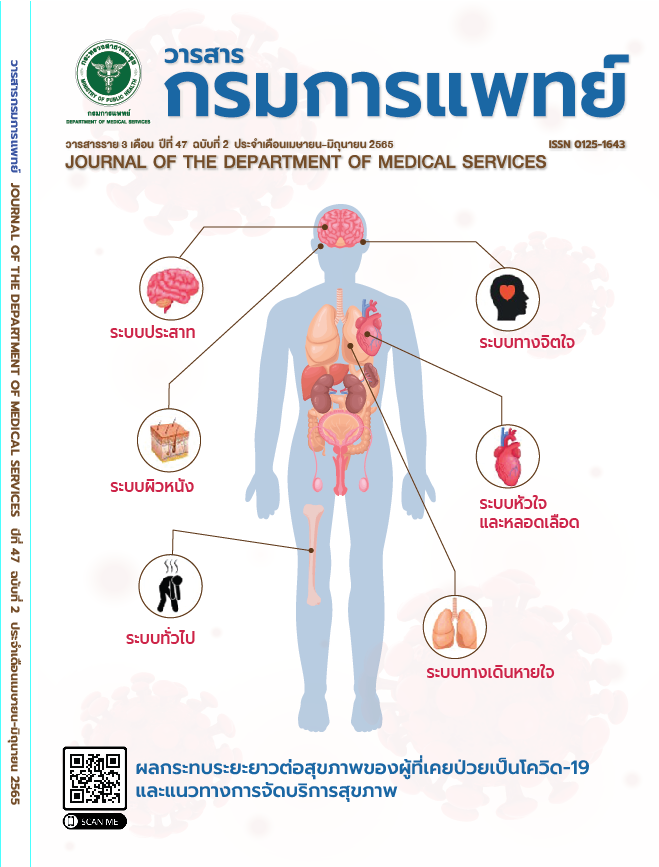ผลของการใช้แบบประเมินการคัดกรองโดยใช้สัญญาณเตือน ภาวะวิกฤตร่วมกับการดูแลตามมาตรฐานการพยาบาลผู้ป่วยเด็ก โรคไข้เลือดออกต่อผลลัพธ์การปฏิบัติการพยาบาล ในสถาบันสุขภาพเด็กแห่งชาติมหาราชินี
คำสำคัญ:
การคัดกรองโดยใช้สัญญาณเตือนภาวะวิกฤตในเด็ก, มาตรฐานการพยาบาลผู้ป่วยเด็กโรคไข้เลือดออก, โรคไข้เลือดออกบทคัดย่อ
ภูมิหลัง: โรคไข้เลือดออกนับเป็นสาเหตุที่สำคัญของการป่วยและการตายในเด็ก โดยเฉพาะระยะวิกฤต/ช็อก จะมีการเปลี่ยนแปลงอย่างรวดเร็ว ถ้าไม่ได้รับการดูแลรักษาผู้ป่วยจะมีอาการเลวลงอาจเสยชีวีตได้ พยาบาลมบทบาทสำคัญในการประเมินอาการอันตรายที่จะเกิดขึ้นกับผู้ป่วย ดังนั้นการนำแบบประเมิน การคัดกรองโดยใช้สัญญาณเตือนภาวะวิกฤต (PEWS) ร่วมกับการดูแลตามมาตรฐานการพยาบาลผู้ป่วยโรคเด็กไข้เลือดออกในระยะวิกฤต มาใช้ในการเฝ้าระวัง ติดตาม ประเมินอาการเปลี่ยนแปลงของผู้ป่วยช่วยให้สามารถแบ่งระดับความรุนแรงนำไปสู่การตัดสินใจในการให้การดูแลรักษาพยาบาล และเฝ้าระวังติดตามอาการเปลี่ยนแปลงผู้ป่วยได้อย่างรวดเร็ว ถูกต้อง เป็นมาตรฐานเดียวกัน ทำให้ผู้ป่วยได้รับการดูแลรักษาอย่างทันท่วงที ป้องกันการเกิดภาวtแทรกซ้อนที่รุนแรง วัตถุประสงค์: เพื่อศึกษาผลของการใช้แบบประเมินการคัดกรองโดยใช้สัญญาณเตือนภาวะวิกฤตร่วมกับการดูแลตามมาตรฐานการพยาบาลผู้ป่วยเด็กโรคไข้เลือดออกต่อผลลัพธ์การปฏิบัติการพยาบาล วิธีการ: การวิจัยครั้งนี้เป็นการวิจัยแบบกึ่งทดลอง (quasi-experimental research) กลุ่มตัวอย่างคือผู้ป่วยเด็กโรคไข้เลือดออก อายุตั้งแต่ 6-15 ปี โดยแบ่งเป็นกลุ่มทดลอง และกลุ่มควบคุม กลุ่มละ 20 ราย สถิติทีใช้ในการวิเคราะห์ข้อมูล คือ chi-squared test และ independent sample t-test ผล: ผู้ป่วยกลุ่มทดลองมีระดับความรุนแรงของโรคน้อยกว่ากลุ่มควบคุมอย่างมีนัยสำคัญทางสถิติ (p<0.05) และผู้ป่วยกลุ่มทดลองมีจำนวนวันนอนในโรงพยาบาลเฉลี่ยน้อยกว่ากลุ่มควบคุมอย่างไม่มีนับสำคัญทางสถิติ (p>0.05) รวมถึงความพึงพอใจของพยาบาลวิชาชีพต่อการใช้แบบประเมินการคิดกรองโดยใช้สัญญาณเตือนภาวะวิกฤติร่วมกับการดูแลตามมาตรฐานการพยาบาลผู้ป่วยเด็กโรคไข้เลือดออกอยู่ในระดับมากที่สุดเฉลี่ยร้อยละ 85.94 สรุป: เครื่องมือ PEWS ช่วยในการเฝ้าระวัง และสามารถดักจับอาการของผู้ป่วยเด็กโรคไข้เลือดออกที่แย่ลงได้ อย่างรวดเร็ว และยังสามารถลดระดับความรุนแรงของโรคได้ รวมทั้งสามารถลดจำนวนวันนอนในโรงพยาบาลได้
เอกสารอ้างอิง
Bureau of Epidemiology. Dengue fever situation in Thailand. 2018. [Online]. http://www.ddc.moph.go.th/uploads/ckeditor/6f4922f45568161a8cdf4ad2299f6d23/files/Report/Annual%20Report/pdf.
Department of Medicine Statistics. Dengue hemorrhagic fever patient statistics Queen Sirikit National Institute of Child Health. (2015-2018). Bangkok: Department of Medicine Statistics Queen Sirikit National Institute of Child Health.
Kulayanaroojj S and Vangveeravong Diagnosis and treatment of dengue hemorrhagic fever for doctor. Bangkok: Department of Disease Control, Ministry of Public Health; (2018).
Sanprasarn P. Quality Standards and Nursing Standards. as cited in. Sanprasarn P, Jamsomboon K and Watradull D. (Editor), Nursing Standards of CVT: Concept of quality developement. Bangkok: Sukhumvit; (2008).
Brighton Cincinnati. Provincial PEWS Vital Sign, Assessment & Documentation Guideline. CHILD HEALTH; 2018; 8-11.
Monaghan A. Detecting and managing deterioration in children: Alan Monaghan describes how the introduction of a critical care outreach service and a Pediatric Early Warning Score improved management of acutely ill children. Pediatric nursing. 2005; 17(1): 32-35.
Tanaree J. The efficacy of the Pediatric Early Warning Score : PEWS in the pediatric ward at
Kamphaeng Phet Hospital. 2016.[Online]. http://www.thaipediatrics.org/Media/media-20180620144707.pdf
Pimjaichon R. The effect of the use surveillance for variation change and warning signs on unplanned transfer in critical room. 2018. [Online]. http://www.cbh.moph.go.th/app/intranet/files/km/1507186947_8.
Mandell I. M, Bynum F, Marshall L, Bart R, Gold J. I, Rubin S. Pediatric Early Warning Score and unplanned readmission to the pediatric intensive care unit. Journal of critical care. 2015; 30(5); 1090-1095.
Ennis L. Pediatric early warning score on a children’s ward: a quality improvement initiative: Linda Ennis discusses the implementation and evaluation of a track and trigger system to improve the care, referral and outcomes for acutely ill young patients. Nursing children and young people. 2014; 26(7); 25-31.
Sirikut P. Dengue Hemorrhagic Fever. as cited in Makornsarn C. (Editor), Thailand medical
service profile 2011-20114. Bangkok: Department of Medical Service , Ministry of Public Health; 2014; 18-1-33.
Kulayanaroojj S, Vangveeravong M, Vatcharasaevee W. Diagnosis and treatment of dengue hemorrhagic fever. Bangkok: Department of Disease Control, Ministry of Public Health; (2017).
Srikhaorot O. Effect of using the standard of nursing care model for pediatric acute respiratory tract infection with pediatric early warning system on professional nurses satisfaction. Degree of Master of Nursing. Thesis, Department of Nursing Science Field, Faculty of Nursing Chulalongkorn University; 2019.
ดาวน์โหลด
เผยแพร่แล้ว
รูปแบบการอ้างอิง
ฉบับ
ประเภทบทความ
สัญญาอนุญาต
ลิขสิทธิ์ (c) 2022 กรมการแพทย์ กระทรวงสาธารณสุข

อนุญาตภายใต้เงื่อนไข Creative Commons Attribution-NonCommercial-NoDerivatives 4.0 International License.
บทความที่ได้รับการตีพิมพ์เป็นลิขสิทธิ์ของกรมการแพทย์ กระทรวงสาธารณสุข
ข้อความและข้อคิดเห็นต่างๆ เป็นของผู้เขียนบทความ ไม่ใช่ความเห็นของกองบรรณาธิการหรือของวารสารกรมการแพทย์



